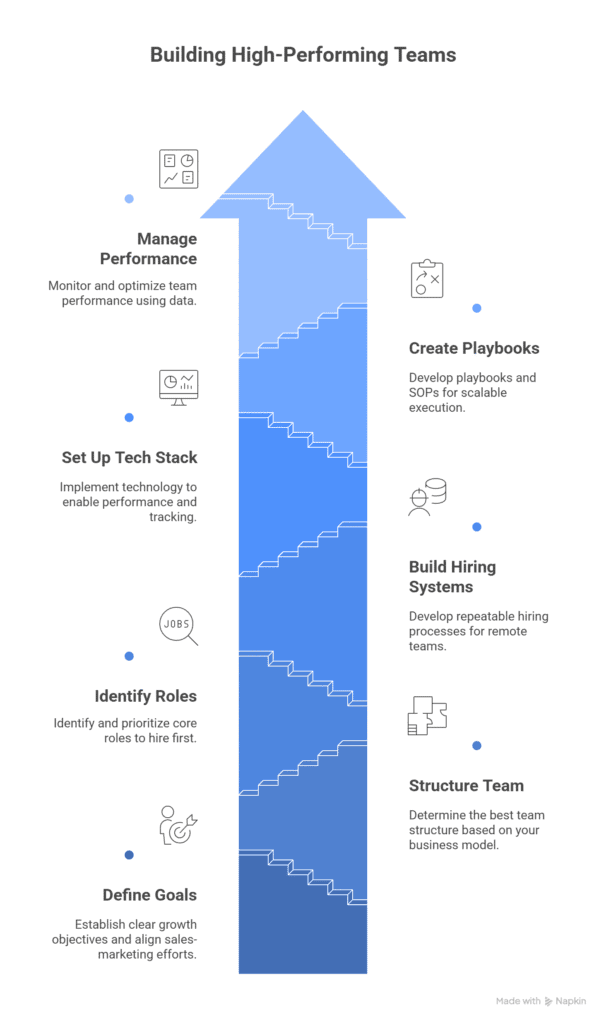Trying to build a high-performing sales or marketing team? To structure strong marketing and sales teams you must follow these steps:
- Define your growth goals and sales-marketing alignment
- Decide team structure based on your business model
- Identify core roles to hire first
- Build repeatable hiring systems for remote teams
- Set up tech stack to enable performance and tracking
- Build playbooks and SOPs for scalable execution
- Manage performance and optimize based on data
To successfully build these teams, you must understand the unique responsibilities each role entails, from lead generation to closing deals. This guide will walk you through essential steps and best practices for assembling high-performing sales and marketing teams that can adapt to your specific needs, eventually positioning your business for sustained success in any niche.

#1. Define Your Growth Goals and Sales-Marketing Alignment
Defining growth goals and ensuring alignment between sales and marketing sets the foundation for success. Both teams must work towards shared targets to effectively drive business growth and improve customer satisfaction.
Set Revenue Milestones and CAC/LTV Targets
Set clear revenue milestones to measure success. Know your Customer Acquisition Cost (CAC) and Customer Lifetime Value (LTV). These metrics indicate how much you can spend on marketing and sales while still turning a profit.
For instance, if your CAC is $200, aim for an LTV of at least three times that, so $600 or more. This creates a profitable balance that supports sustainable growth.
Choose Between Inbound, Outbound, or Hybrid GTM Strategy
Choose the go-to-market (GTM) strategy that fits your business needs. Inbound strategies attract customers through valuable content, while outbound focuses on direct outreach. Hybrid strategies combine both, leveraging benefits from each approach.
Assess your audience and resources to determine the most effective GTM strategy that aligns with your team’s goals and capabilities.
Clarify Ownership Between Sales and Marketing Teams
Clarify roles and responsibilities between sales and marketing. Specify who handles lead generation, nurturing, and closing sales. Without clear ownership, leads can slip through the cracks.
Assign ownership of various customer touchpoints to promote accountability. This fosters a cohesive effort that drives better outcomes.
Identify Key KPIs: SQLs, Pipeline Velocity, Conversion Rates
Identify key performance indicators (KPIs) that matter. Focus on Sales Qualified Leads (SQLs), pipeline velocity, and conversion rates. SQLs indicate leads ready for sales engagement. Pipeline velocity tracks how quickly leads move through sales stages.
Conversion rates measure the percentage of leads that become customers. Monitoring these KPIs provides insights into performance, allowing for timely adjustments in strategy.
Map Customer Journey and Buying Triggers
Map the customer journey to understand their decision-making process. Identify key buying triggers that motivate action at each stage. Define touchpoints such as awareness, consideration, and decision.
This mapping provides clarity on how both teams can collaborate to nurture leads effectively. By knowing what influences prospects, you can tailor your marketing and sales efforts to meet their needs.
#2. Decide Team Structure Based on Business Model
Choosing the right structure for your sales and marketing teams greatly impacts your business’s growth. Think of your company’s needs and how to meet them with an effective team layout.
Compare SDR/AE Model vs. Full-Cycle Reps for B2B
Sales Development Representatives (SDRs) focus on lead generation, while Account Executives (AEs) close deals. This separation allows SDRs to hone in on finding qualified leads without the pressure of closing. The full-cycle rep model combines both functions into one role, enabling individuals to control the sales process from start to finish.
Ask yourself: Do you prefer specialization or versatility? A dual structure can boost efficiency but may require more training and alignment. Conversely, full-cycle reps offer agility but may dilute accountability. Reflect on which model aligns best with your sales goals.
Choose Between Freelancers, Agencies, or In-House Hires
Selecting between freelancers, agencies, or full-time hires hinges on your resources and specific needs. Freelancers often provide flexibility and expertise without long-term commitments. Agencies deliver comprehensive strategies and might be cost-effective for niche skills. In-house hires create continuity and deeper brand understanding but also involve long-term investments in salary and benefits.
Weigh these options against your budget and time constraints. If your project’s scope fluctuates, freelancers may suit you better; if you crave constant oversight, consider in-house staff. Pro tip: Start with a mix of freelancers for specialized tasks while building your core in-house team.
Build a Marketing Team by Funnel Stage: TOFU, MOFU, BOFU
An effective marketing team aligns with the buyer’s journey. Structure your team by funnel stages:
- Top of Funnel (TOFU) focuses on creating awareness through content marketing, social media, and SEO.
- Middle of Funnel (MOFU) nurtures leads with targeted email campaigns, webinars, and case studies.
- Bottom of Funnel (BOFU) centers on closing deals using product demos, consultations, and trial offers.
Match roles to these stages to ensure coverage. For instance, TOFU teams should excel in creativity, while BOFU teams need strong negotiation skills. By aligning roles with funnel objectives, you ensure no leads fall through the cracks.
And of course, you can have marketing or sales team members managing more than one stage of the funnel. Be smart, think about this principles when you scale your team.
Structure Teams for Lifecycle Stages: Acquisition, Activation, Retention
Same principle as understanding your marketing funnel, but this can be more interesting for some types of companies. Divide your teams into distinct functions based on their interactions:
- Acquisition focuses on obtaining new customers through marketing efforts and outreach.
- Activation aims at engaging those customers and turning them into active users.
- Retention focuses on keeping customers satisfied and loyal.
This segmentation clarifies each team’s purpose, driving accountability and results. It also supports better communication. Use tools like shared dashboards to monitor performance and share insights easily.
Integrate Nearshore and Offshore Roles for Cost Efficiency
Think about mixing nearshore and offshore roles for cost savings without sacrificing quality. Nearshore teams can offer similar time zones and cultural understanding, while offshore teams often provide substantial cost reductions.
Before diving in, evaluate your communication capabilities and project management tools. Consider time zone impacts on collaboration; misalignment can lead to delays. Use technology to bridge gaps in geography and culture, ensuring seamless integration. If executed well, these offshoring or nearshoring strategies boosts efficiency and lowers costs, propelling growth while maintaining team performance.
#3. Identify Core Roles to Hire First
Building effective sales and marketing teams starts with identifying key roles that will drive growth. Each role should align with your specific business needs and contribute to a cohesive strategy.
Priority Sales Hires: SDR, Account Executive, RevOps
You’ll want to prioritize hiring a Sales Development Representative (SDR) to generate leads. This role focuses on cold outreach and qualifying potential customers. An effective SDR sets the foundation for your sales pipeline.
Next, bring on an Account Executive who closes those leads. This person converts prospects into clients and drives revenue. Consider adding Revenue Operations (RevOps) to streamline processes and analyze data across teams.
RevOps ensures your sales strategies align with broader business goals and adapts them based on performance metrics.
Priority Marketing Hires: Content Marketer, Paid Ads Manager, SEO Specialist
For your marketing team, start with a Content Marketer. They create engaging content that attracts and retains customers. Think blogs, videos, and social media posts.
After that, bring in a Paid Ads Manager to handle online advertising campaigns. They’ll increase your visibility and drive traffic. Finally, an SEO Specialist is crucial. They’ll optimize your content so it ranks high in search engines, enhancing your online presence.
Support Roles: Marketing Coordinator, Sales Assistant, CRM Specialist
Support roles help to maintain efficiency. Hire a Marketing Coordinator to manage campaigns and ensure timely execution. A Sales Assistant can help track leads and provide administrative support, freeing up your team to focus on closing deals. Consider a CRM Specialist to maintain your customer relationship management system, ensuring data is accurate and actionable.
Role Scoping and Deliverables for Each Function
Clearly define the responsibilities and deliverables for each role. For example, your SDR should be responsible for making a certain number of calls daily and scheduling meetings for Account Executives.
The Account Executive needs to meet monthly sales quotas and maintain a healthy pipeline. Your Content Marketer should produce weekly content pieces and track engagement metrics. Establishing these deliverables keeps everyone focused on meeting your objectives.
By identifying and hiring core roles strategically, you position your business for growth while ensuring every team member contributes meaningfully to your objectives.
#4. Build Repeatable Hiring Systems for Remote Teams
Creating effective hiring systems for remote teams streamlines the recruitment process and ensures you find the right talent. A structured approach helps you maintain quality as your business scales.
Create Scorecards Aligned With Business Objectives
Develop scorecards that reflect your business goals. List essential skills, traits, and outcomes that align with your objectives.
For example, if your target is increased lead conversion, prioritize candidates with strong communication and persuasion skills. Scorecards aid in removing bias during evaluations. They provide clear criteria for each role and keep your team focused on what truly matters.
Source Talent: Job Boards, LinkedIn, Remote Staffing Agencies
Tap into the right platforms to find potential hires. Use job boards specific to your industry, such as We Work Remotely or Remote.co. Post clear job listings on LinkedIn to attract qualified candidates.
Remote staffing agencies, like Scale Army, offer quick access to vetted professionals, saving you time during the initial screening. Your sourcing strategy should be a mix, ensuring you expand your reach while finding talent that fits your culture.
Interview Frameworks for Asynchronous and Live Evaluations
Design an interview framework that accommodates asynchronous and live evaluations. For asynchronous interviews, use recorded video responses to gauge candidates’ communication skills. Live interviews allow for deeper exploration of their experiences.
Prepare targeted questions that reflect the scorecard criteria. This dual approach reveals candidates’ abilities to articulate their thoughts clearly, whether they’re in a room or speaking to a camera.
Trial Projects and Onboarding SOPs
Carry out trial projects as part of your hiring process. Assign relevant tasks to test candidates’ skills in action. This method showcases their problem-solving abilities and how they fit into your team dynamics. After hiring, focus on structured onboarding.
Create Standard Operating Procedures (SOPs) that outline expectations, tools, and workflows. Proper onboarding ensures new hires feel welcomed and equipped to succeed from day one.
#5. Set Up Tech Stack to Enable Performance and Tracking
Choosing the right tech stack boosts your sales and marketing efforts. You need systems that enable performance tracking and help communication.
Let’s break down essential tools that make this happen.
CRM Systems: HubSpot, Pipedrive, Salesforce
A Customer Relationship Management (CRM) tool tracks interactions with prospects. HubSpot, Pipedrive, and Salesforce rank among the best. Each offers unique features. HubSpot shines in user-friendliness with its all-in-one platform.
Pipedrive excels at visual sales pipelines. Salesforce provides customization options for larger teams. Your CRM choice impacts how effectively you guide leads through the sales funnel. Test different systems to find one that fits your team’s workflow.
Sales Enablement Tools: Apollo, Close, Loom
Sales enablement tools enhance your sales process. Apollo helps with prospecting by providing accurate lead data. Close facilitates communication through embedded calling capabilities.
Loom allows your sales team to create personalized video messages. These tools streamline outreach and improve your team’s efficiency. Select the ones that match your sales strategy. Don’t overlook training; ensure your team knows how to maximize these tools.
Marketing Stack: Social Media Tools, Analytics, Notion, SEO Tools
A solid marketing stack includes social media tools for managing campaigns, analytics for tracking performance, and SEO tools to increase visibility. Use Notion for collaborative project management and team documentation.
Hootsuite or Buffer can handle social media posts effectively. Google Analytics provides invaluable insights into visitor behavior. SEMrush or Ahrefs can guide your SEO strategy. Assemble a mix of tools that enable tracking and analysis across all channels to optimize campaigns and make data-driven decisions.
Communication Tools: Slack, Zoom, Loom, ClickUp
Effective communication tools keep your sales and marketing teams aligned. Slack enables quick messaging and file sharing, making it ideal for instant updates. Use Zoom for face-to-face meetings, especially for remote teams.
Loom helps with sharing detailed information through video messages, allowing for clear explanations. ClickUp organizes tasks and timelines, ensuring everyone stays on track. Choose tools that streamline communication for your specific team setup.
Automate Reporting and Attribution for ROI Analysis
Automating reporting saves time and provides clearer insights into performance. Tools like Google Data Studio or Tableau can compile data from various sources into a single dashboard. Use these tools to assess ROI and track performance metrics efficiently.
Attribution models clarify which channels drive conversions. Understanding these connections helps refine your strategies. Focus on automating what you can; it’ll free up your time for more strategic planning.
Make these choices thoughtfully and integrate them continuously. Your tech stack should evolve with your needs.
Get ready to watch performance soar as teams collaborate seamlessly.
#6. Build Playbooks and SOPs for Scalable Execution
Creating playbooks and Standard Operating Procedures (SOPs) ensures your sales and marketing teams work efficiently and consistently, especially in a remote-first setting. These tools act as roadmaps for daily tasks, driving alignment and execution.
Document Sales Outreach Sequences and Follow-Ups
Start by outlining clear outreach sequences. This includes every touchpoint, follow-up, and the rationale behind them. By documenting these sequences:
- You clarify expectations. Team members understand their roles in the outreach process.
- You increase accountability. Each rep knows the proper steps to take at each stage.
- You streamline training. New hires can ramp up quickly, understanding what works based on documented successes.
Consider using tools like Google Docs or Notion for easy updates and collaboration. Fair warning: keeping outreach sequences fresh will save you headaches later.
Define Content Workflows: Brief Creation to Distribution
Map out content workflows from idea generation to distribution. This structured approach helps ensure no potential lead goes unnoticed.
- You promote clarity. Each team member knows their responsibilities, from content creation to approval processes.
- You enhance teamwork. Set guidelines about who reviews what and when.
- You ensure timely delivery. Timelines motivate teams to hit deadlines.
Use project management tools like Asana or Trello to track progress and enable transparency.
Create Lead Qualification Criteria and Routing Rules
Establish clear lead qualification criteria and routing rules that dictate how leads are scored and passed between sales and marketing.
- You’ll improve efficiency. Teams focus on leads that matter, eliminating guesswork.
- You enhance collaboration. Shared criteria ensure both teams work toward common goals.
Craft a scoring system that evaluates leads based on engagement, fit, and source. Use this data to define how marketing qualifies leads and when to hand them off to sales.
Align Marketing Campaigns With Sales Targets
Ensure your marketing campaigns directly support sales targets. Your marketing team needs to know what sales goals are.
- You align efforts. Campaigns become more relevant when linked to actual sales objectives.
- You boost ROI. Fewer resources are wasted on unproductive campaigns.
Regularly discuss ongoing campaigns and sales forecasts in team meetings. This dialogue can adjust marketing strategies on the fly.
Set Up Weekly Dashboards and Team Syncs
Create weekly dashboards that visualize key performance indicators (KPIs) for both sales and marketing. This transparency fosters a culture of accountability.
- You keep everyone informed. Dashboards show progress towards targets, allowing for immediate adjustments.
- You promote collective success. Celebrate wins together—everyone benefits from a combined approach.
- Schedule regular team syncs to discuss performance and tweak plans based on insights from the dashboards. Collaboration breeds innovation and growth.
Incorporate these strategies into your operations, and watch as your teams become more aligned, efficient, and productive in driving sales growth.
#7. Manage Performance and Optimize Based on Data
Successful sales and marketing teams rely on data-driven decisions. Use performance management techniques to focus your efforts, optimize strategies, and drive growth.
Weekly Pipeline Reviews and Campaign Performance Reports
Conduct weekly pipeline reviews to track progress and communicate results. Focus on key metrics like lead conversion rates and sales velocity. Jump into campaign performance reports to analyze success and areas for improvement.
This regular review process builds accountability and allows for quick adjustments, ensuring you’re always moving toward your goals.
Evaluate CAC Payback Period and Channel Profitability
Look closely at your Customer Acquisition Cost (CAC) payback period. Determine how long it takes to recoup your investment in acquiring a new customer. Faster payback periods improve cash flow, allowing you to reinvest in growth.
Assess channel profitability by analyzing which marketing channels yield the highest return on investment (ROI). Focus resources on the most effective pathways.
A/B Test Messaging, Offers, and Funnel Steps
Don’t underestimate the power of A/B testing. Experiment with different messaging, offers, and funnel steps to see what resonates. Run tests for a week and compare outcomes. Use clear criteria for success, such as click-through rates or conversion rates.
These insights lead to better-targeted campaigns and higher engagement.
Set Quarterly OKRs for Sales and Marketing Teams
Set quarterly Objectives and Key Results (OKRs) for your sales and marketing teams. These goals foster alignment and clarity. For instance, aim for specific revenue milestones or lead generation targets.
Keep everyone accountable and focused. Regularly revisit these OKRs to evaluate progress and make necessary adjustments.
Replace Underperformers and Upskill Top Performers
Identify underperforming team members and take action. If someone isn’t hitting their targets, figure out if it’s a skills issue or a role mismatch. Coupled with this, invest in upskilling your top performers. Offer them training and development opportunities. This creates a culture of growth that benefits your whole team and drives better results.
When to Scale and Hire for Growth
Recognizing the right time to expand your sales and marketing teams can transform your business. Spotting key hiring triggers ensures you’re not just reacting but proactively scaling for success.
Hiring Triggers: Lead Volume, Pipeline Bottlenecks, Missed SLAs
If you’re swamped with leads but can’t follow up quickly, it’s time to act. A surge in lead volume signals you may need more hands on deck. Feeling bottlenecks in your pipeline? That’s a glaring indicator. You need dedicated reps to keep up the momentum.
Missed Service Level Agreements (SLAs) highlight gaps in your response time. If your team struggles to meet these deadlines, hiring more staff can improve efficiency and keep prospects happy.
Expand Functions: Product Marketing, Customer Success, Channel Sales
Expanding roles can elevate your business. Consider hiring a Product Marketer if your offerings require clear messaging. They’ll ensure your products resonate with your market.
Investing in Customer Success personnel will help retain clients and secure repeat business. Think about Channel Sales as well. Building partnerships can drive revenue through shared networks. Brushing up against these functions isn’t just smart—it’s essential for long-term growth.
Build Leadership Layer: Sales Manager, Head of Marketing
Every great team needs strong leaders. If you can’t keep sight of goals or nurture talent, it may be time to hire a Sales Manager.
They’ll mentor your sales reps and refine strategies. Similarly, a Head of Marketing can craft campaigns that align with your vision. Leadership fosters accountability. It cultivates an environment where your teams collaborate effectively and deliver impressive results.
Use Benchmarks to Justify New Hires (Leads/Rep, SQLs/Marketer)
Benchmarks lay a solid foundation for your hiring strategy. Track metrics like leads per rep and SQLs per marketer.
These numbers show if your team’s workload matches its capabilities. If you find that reps handle too many leads, it’s time for additional hires. Proving the need for more staff with hard data makes the case compelling. Aligning resources with demand ensures your team isn’t stretched thin, enhancing overall performance.
Align Hiring Roadmap With Revenue Forecasts
A clear hiring roadmap linked to revenue forecasts sets expectations. Know your financial goals and the roles needed to achieve them.
Align hires with projected growth to maintain a steady upward trajectory. This strategic planning minimizes the risk of overhiring or underestimating your needs. When your hiring aligns with revenue forecasts, you’re not just staffing—you’re powering your business’s future growth.
Let’s be honest—scaling can feel overwhelming. But recognizing these triggers, expanding functions, building leadership, leveraging benchmarks, and aligning your roadmap can position you effectively. Every step taken today paves the way for tomorrow’s success.
Why Partner with a Global Staffing Agency to Build Strong Teams
Building effective sales and marketing teams is a journey that requires strategic planning and execution. By leveraging the right talent and technology you can create an environment that fosters collaboration and drives growth.
Partnering with a global staffing agency, like Scale Army, can provide you access to a diverse pool of skilled professionals who align with your business needs. This approach not only streamlines the hiring process but also ensures you find candidates who fit your company culture.
As you scale your teams keep in mind the importance of continuous improvement and accountability. By investing in the right resources and maintaining open lines of communication you can enhance performance and eventually achieve your business objectives.




